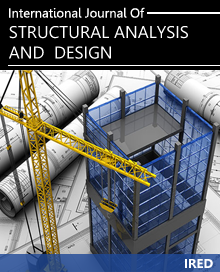Effect of strength class of concrete and curing conditions on apparent volume of permeable voids of self-compacting and conventional concrete
Author(s) : EMINE EBRU DEMIRCI , REMZI SAHIN
 Abstract
Abstract
The purpose of this study is to compare Self Compacting Concrete (SCC) and Conventional Concrete (CC) which are used in beams with dense reinforcement, in terms of their apparent volume of permeable voids (AVPV). During the comparison of SCC and CC, the effects of two different factors were also investigated: strength class of concrete and curing condition. In the study, both SCC and CC were produced in three different strength classes (C25, C50 and C70) and the other parameter (i.e. curing condition) was determined as two levels: moisture and air curing. Beam dimensions were determined to be 200x250x3000 mm. The AVPV measurements were performed on core samples taken from the beams. Core samples of ø8x5 cm were taken from the beginning (0-100 cm), middle (100-200 cm) and end (200-300 cm) region of the beams according to the casting direction of SCC. In the study, AVPV experiments were performed according to Turkish Standard 3624. It was observed that, for both SCC and CC, AVPV values of samples kept in moisture curing are significantly lower than that of samples stored in air curing. For CC’s; C25, C50 and C70 class moisture-cured samples were found to have 6%, 6% and 10% lower AVPV values, respectively, when compared to the air-cured ones. For SCC’s; these values were 4%, 8% and 13%, respectively. It was also found that, for both curing environments and all strength classes of concrete, SCC’s had lower AVPV values than that of CC’s. The AVPV values of C25 class of SCC are 7% and 5% lower than that of C25 class of CC for air and moisture conditions, respectively. Emine Ebru Demirci General Directorate of Highways, 12th Reg. Dir., Erzurum, Turkey Remzi Şahin Atatürk University, Engineering Fac., Dept of Civil Eng., Erzurum Turkey For C50 class, these decreases were 7% and 9%, while for C70 class, they were 10% and 13%, respectively. Apart from that, it was determined that AVPV values for both SCC and CC decrease with increasing strength class of concrete for both curing environments. It was found that, for air cured CC, C50 and C70 class of concretes had 16 % and 35 % lower AVPV values compared to the C25 class of concrete. For the same type of concrete samples cured in the moisture environment, these values were found to be 16% and 38%. It was found that for SCC samples, AVPV value of C50 and C70 concretes, which were kept in air curing, were 16% and 37% lower than that of C25, while for moisture-cured samples these values were 19% and 43%, respectively. When standard deviations of the AVPV values are compared for core samples obtained from the beginning, middle and end of the CC and SCC beams, it was found that, in all three strength classes of concrete, the variation is much smaller for SCC than CC. This demonstrated that SCC’s had more uniform character than CC’s.
 Full Paper PDF
Full Paper PDF
